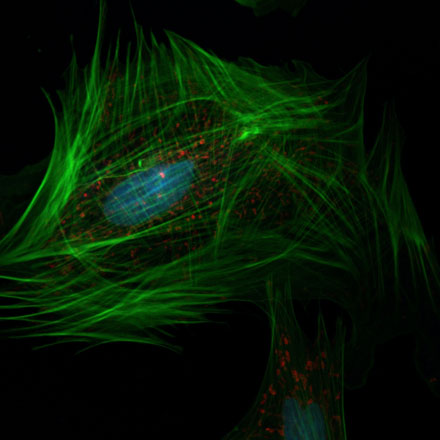|
Tuesday, October 17, 2023 |
|
|
|
Presented by
|

|
|

|
Fluorescence microscopy has revolutionized life sciences by enabling researchers to study biological samples with exceptional precision. New excitation and illumination light sources and scientific cameras have been developed to enable exciting research with fluorescence microscopy in all its advanced applications. Traditionally, the visible (VIS) spectral range was used for fluorescence excitation and detection in life sciences, especially in microscopy. In addition to the VIS, there are spectral ranges such as UV and deep UV on one side and near-IR (NIR) and short-wave IR (SWIR) on the other side of the spectrum. In recent years, the NIR range has become popular in fluorescence microscopy due to microscopy techniques such as two-photon and three-photon excitation, allowing for precise excitation of fluorophores deeper within biological samples. NIR and the subsequent SWIR range wavelengths enable visualization and detection of features, characteristics, and spectral fingerprints that cannot be seen in the VIS part of the spectrum.
This presentation highlights new versatile and reliable light sources and a new InGaAs camera system, pco.pixelfly™ 1.3 SWIR, which each provide solutions for scientific questions in both the VIS and the SWIR range. In addition to discussing the features of the light sources and the camera system, Kavita Aswani and Gerhard Holst address application areas ranging from VIS to SWIR fluorescence in biomedical applications such as in vivo and intra-vital microscopy. They also present examples of multispectral imaging using multi-component analysis. A prerequisite for this type of imaging is a bright and reliable light source for excitation of fluorophores, which emit from the VIS to NIR range. Next, they share about X-Cite® light sources, which feature high excitation power for fluorescence and absorption applications across the UV, VIS, and NIR spectrums. Finally, the presentation addresses corresponding requirements for effortless imaging to optimize the seamless combination of the X-Cite® fluorescence light sources and PCO® cameras in biomedical imaging applications.
Who should attend:
Scientists, researchers, laboratory technicians, clinicians, and others in the fields of biology, biotechnology, microbiology, and other areas of the life sciences who are using fluorescence across multiple wavelengths for microscopy. Those working in biophotonics utilizing technology such as cameras, imaging, and LEDs.
About the presenters:
Kavita Aswani, Ph.D., serves as the senior applications scientist for biomedical products at Excelitas Technologies. She earned her doctorate from the University of Iowa, and she boasts an extensive background encompassing seven years of scientific research expertise and over 23 years of applications experience in the fields of microscopy and fluorescence industry. Throughout her career, Aswani has contributed to numerous publications and peer-reviewed journal articles. Her specialized areas of work include widefield illumination microscopy, laser scanning microscopy, and flow cytometry. She remains an engaged member of both the Society for Neuroscience and the Royal Microscopical Society.
Gerhard Holst, Ph.D., is senior imaging product and application scientist at Excelitas Technologies. He graduated at the Technical University Aachen, Germany, with a diploma in electrical engineering in 1991 and went on to complete his doctorate at the University of Dortmund in collaboration with the Max-Planck-Institute for Systemphysiology in Dortmund, Germany in 1994. Holst furthered his research as member of the Microsensor Research Group at the Max-Planck-Institute for Marine Microbiology in Bremen, Germany from 1994 to 2001. From 2001 through 2021 he was head of the research and science department at PCO AG, where he was responsible for new technologies, research, and sensor projects, including the development of sCMOS image sensors.
About Excelitas Technologies Corp.:
Excelitas Technologies® Corp. is a leading industrial technology manufacturer focused on delivering innovative, market-driven photonic solutions to meet the illumination, optical, optronic, sensing, detection, and imaging needs of our OEM and end-user customers. Their X-Cite® light sources deliver high excitation power across UV, VIS, and NIR, and our PCO® InGaAs camera ensures seamless imaging, making them both essential tools for advanced biomedical research.
|
|
|
|
Date: Wednesday, October 18, 2023
Time: 10:00 AM - 11:00 AM EDT
Space is limited. Reserve your Webinar seat now at: https://attendee.gotowebinar.com/register/4383433334979391327?source=eblast
After registering you will receive a confirmation email containing information about joining the Webinar.
|
|
|
SYSTEM REQUIREMENTS
Operating System
Windows® 7 or later, Mac OS® X 10.9 or later, Linux®, Google ChromeTM OS
AndroidTM OS 5 or later, iOS® 10 or later
Web Browser
Google ChromeTM (most recent 2 versions)
Mozilla Firefox® (most recent 2 versions)
Mobile Devices
AndroidTM 5 or later
iPhone® 4S or later
iPad® 2 or later
Windows Phone® 8+, Windows® 8RT+
|
|
|
|
.: More from Photonics Media
|
|
|
|